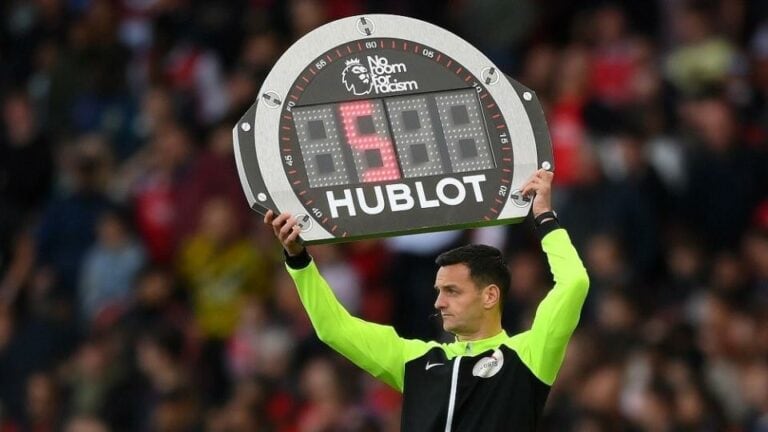It’s no secret that soccer is a high-intensity sport that often requires additional time to determine a winner. However, many people get confused when it comes to the terms “extra time” and “overtime.”
Since soccer matches have a fixed duration of 90 minutes, divided into two halves of 45 minutes each. But what happens when the score remains tied at the end of regulation time?
That’s when extra time or overtime comes into play. While these terms are often used interchangeably, they actually have different meanings and implications.
Let’s dive deeper into each of them.
What is Extra Time?
Extra time and overtime are terms commonly used in the world of soccer to refer to additional playing time when a match ends in a draw at the end of regulation time.
This additional time allows the teams to continue playing in order to determine a winner. However, it is important to note that the terms “extra time” and “overtime” are not always used in the same context and can vary depending on the competition or tournament rules.
When is Extra Time Used?
Extra time is typically used in knockout competitions, such as the FIFA World Cup or UEFA Champions League, where a winner must be determined in order to progress to the next round. When a match ends in a draw at the end of regulation time, the referee signals for an additional period of play known as extra time. This period consists of two halves, usually 15 minutes each, and is played immediately after the end of regulation time. The teams switch sides at the halfway point of extra time, just like they do during halftime in regulation time.
During extra time, the teams continue to play with the same number of players as in regulation time. However, there are some notable differences in the rules. For example, in most competitions, each team is allowed to make an additional substitution during extra time, providing an opportunity for coaches to introduce fresh legs or make tactical changes to try and secure a victory. This extra substitution can often have a significant impact on the outcome of the match.
What is Overtime?
Overtime, on the other hand, is a term commonly used in leagues or competitions that follow a different format than knockout tournaments. In these cases, a match can end in a draw even after extra time, and the teams may be awarded points for the draw. Overtime is usually played in the form of two additional halves, similar to extra time, but the purpose is not to determine a winner. Instead, it serves as an extended period of play to provide more entertainment for the fans and allow teams to accumulate points.
It is worth mentioning that not all soccer competitions utilize extra time or overtime. Some leagues, like Major League Soccer (MLS) in the United States, have adopted a different approach called a “penalty shootout” to determine a winner in the event of a draw at the end of regulation time. In a penalty shootout, each team takes turns shooting penalty kicks, and the team with the most goals after a predetermined number of kicks is declared the winner.
Key Differences Between Extra Time and Overtime
Although extra time and overtime are both used to break a tie in sports, they are distinct in soccer. Overtime is more commonly seen in American sports, such as basketball, baseball, and American football. In these sports, overtime refers to an additional period or periods of play when the score is tied at the end of regulation time.
On the other hand, extra time in soccer is only played in knockout matches or important tournaments. It serves as a means to ensure a winner is determined within the constraints of a single match. In contrast, overtime in American sports can occur during regular season games.
Let’s delve deeper into the concept of overtime in American sports. In basketball, for example, when the game is tied at the end of regulation time, teams play an additional five-minute period. If the score remains tied after the first overtime period, another five-minute period is played. This process continues until a winner is determined. It is worth noting that the number of overtime periods can vary depending on the league and the specific sport.
In baseball, overtime is known as extra innings. When a baseball game is tied at the end of the ninth inning, which is the standard length of a game, additional innings are played until a winner is determined. Extra innings can add an exciting element to the game, as teams strive to score the winning run and secure the victory.
American football also has its own version of overtime. In the National Football League (NFL), for instance, if the score is tied at the end of regulation time, the game proceeds to an overtime period. The team that wins the coin toss at the beginning of overtime gets the first possession. If they score a touchdown on their first possession, they win the game. However, if they only score a field goal, the opposing team gets a chance to possess the ball and attempt to score. If the game remains tied after both teams have had possession, the game ends in a tie during the regular season. In the playoffs, however, the game continues with additional 10-minute periods until a winner is determined.
Now let’s shift our focus back to soccer and explore the concept of extra time further. In soccer, extra time is played in two halves, each lasting 15 minutes. These additional periods are played after the completion of the standard 90 minutes of regulation time. The purpose of extra time is to provide teams with an opportunity to break the tie and determine a winner without resorting to a penalty shootout.
It is important to note that extra time in soccer has its own set of rules. For example, each team is allowed to make a fourth substitution during extra time, in addition to the three substitutions allowed during regulation time. This rule aims to provide teams with the opportunity to refresh their lineup and introduce fresh legs to the game.
Furthermore, in knockout matches, if the score remains tied after the completion of extra time, the game proceeds to a penalty shootout. A penalty shootout is a thrilling and nerve-wracking way to determine the winner, as each team takes turns shooting penalties from the designated spot, with the goalkeepers trying to make crucial saves.
In conclusion, while both extra time and overtime serve the purpose of breaking a tie in sports, they differ in their application and rules. Overtime is more commonly seen in American sports, occurring during regular season games, while extra time is specific to soccer and is played in knockout matches or important tournaments. Understanding these key differences adds to our appreciation of the unique aspects of each sport and the strategies employed to determine a winner.
Scenarios for Extra Time in Soccer
Extra time is used in various scenarios in soccer, particularly in knockout matches. One common scenario is during cup competitions, where a winner needs to be identified to progress to the next round. Examples of such competitions include the FIFA World Cup, UEFA Champions League, and domestic cup tournaments.
During these cup competitions, the intensity on the field reaches its peak as teams fight tooth and nail to secure their place in the next round. The added pressure of extra time adds a whole new dimension to the game, as players push themselves to the limit, both physically and mentally. The crowd’s anticipation grows with every passing minute, creating an electrifying atmosphere in the stadium.
As the clock ticks away, players become more determined, showcasing their skills and tactical prowess. Coaches strategize and make crucial substitutions to gain an advantage over their opponents. The tension in the air is palpable, as fans hold their breath, hoping for their team to emerge victorious.
Another instance when extra time is used is during playoff matches or finals. These matches require a definitive result to determine the overall winner. In such cases, the excitement and pressure build as the teams battle it out for victory in the additional time allocated.
Playoff matches and finals are often the culmination of a season’s hard work and dedication. The stakes are high, and the players are aware that their performance in extra time can make or break their dreams of lifting the trophy. The energy on the field is unmatched, with players leaving everything they have on the pitch.
As the game enters extra time, the crowd’s anticipation reaches a fever pitch. Every pass, every shot, and every save becomes a moment of immense significance. The players dig deep into their reserves of strength and determination, pushing themselves beyond their limits to secure the coveted victory.
Extra time in soccer not only tests the physical abilities of the players but also their mental fortitude. It is a true test of character, as teams must remain focused and composed amidst the mounting pressure. The ability to make split-second decisions and seize opportunities becomes crucial in these high-stakes moments.
In conclusion, extra time in soccer adds an element of drama and excitement to knockout matches, whether it be in cup competitions or playoffs. It showcases the resilience and determination of the players as they strive for victory. The added minutes on the clock create an atmosphere of anticipation and tension, making every moment on the field count.
Common Misconceptions
One common misconception is that extra time is interchangeable with overtime. As explained earlier, these terms have distinct meanings and are used in different sporting contexts. Extra time is specific to soccer, while overtime is primarily used in American sports.
Additionally, some people believe that penalty shootouts are part of extra time. However, penalties only come into play if the score remains tied at the end of extra time. Penalty shootouts are a separate method of determining the winner and are not considered part of extra time itself.
Conclusion
In summary, the differences between extra time and overtime are significant when it comes to soccer. Extra time provides an opportunity for teams to break a tie in knockout matches, while overtime is used in American sports to extend playtime when a game ends in a tie. Understanding these distinctions will enhance your knowledge of the game and eliminate any confusion surrounding these terms. So the next time you find yourself engrossed in a soccer match that goes into extra time, you’ll know exactly what’s at stake.







